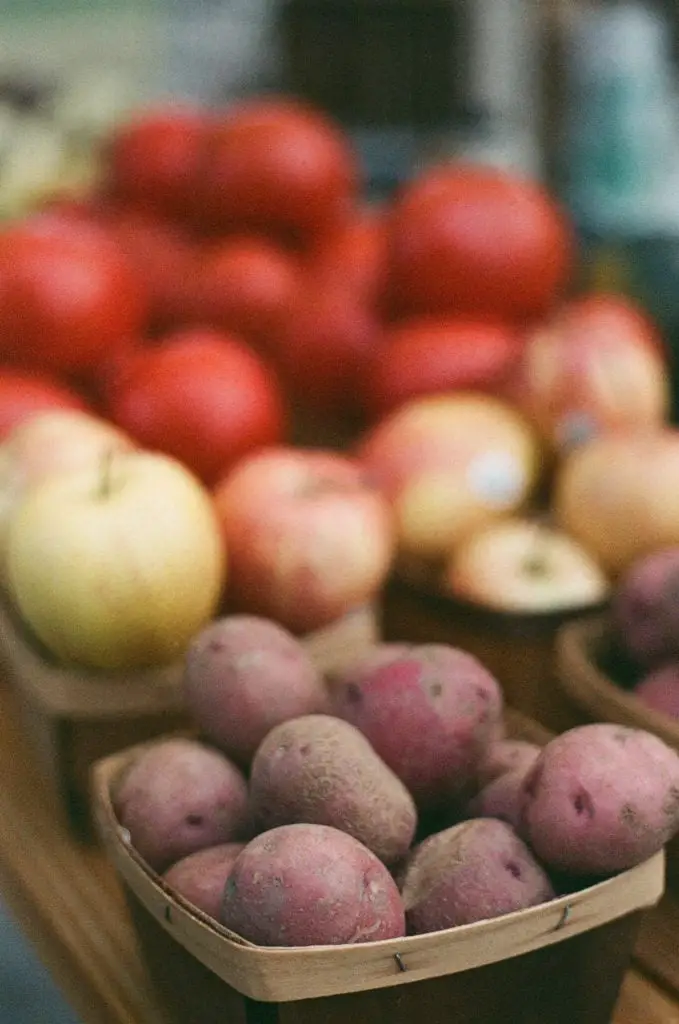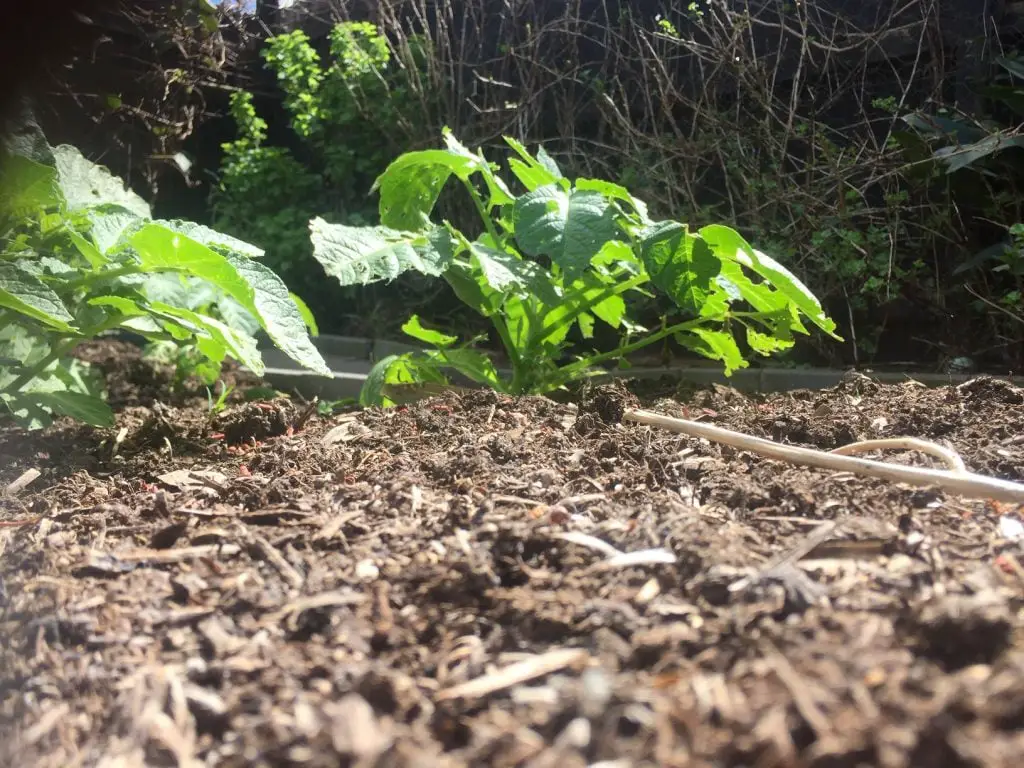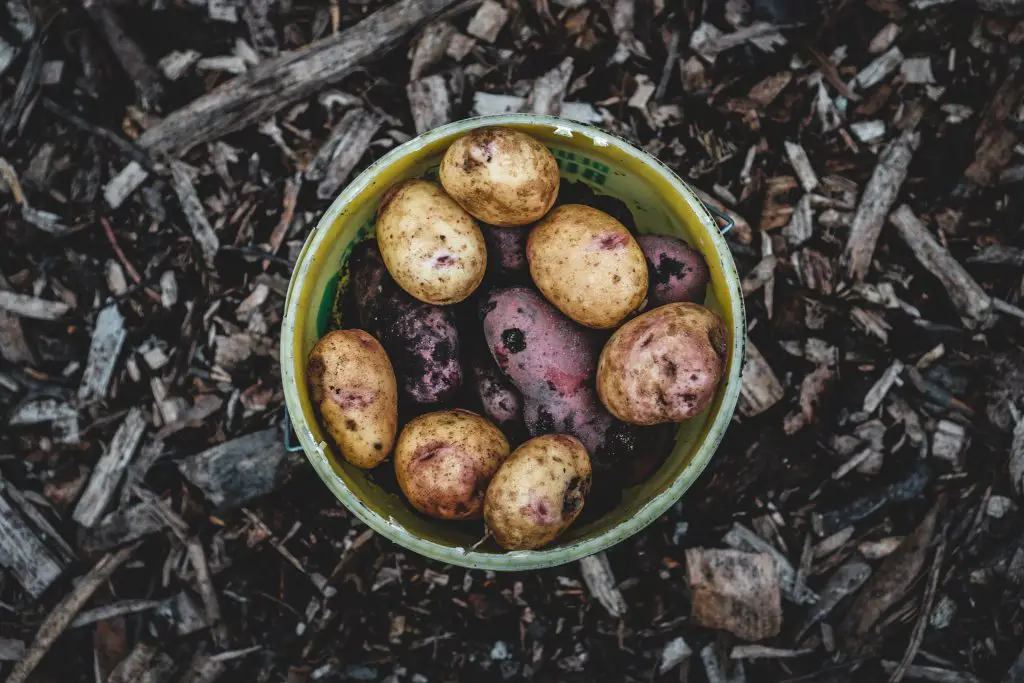Can You Cut Seed Potatoes In Half? Potatoes are one of the easiest potatoes to grow at home, however, one of the most common questions is does the seed potato need to be planted whole or can they be cut in half? And If they are cut in half what are the advantages and disadvantages of cutting them in half?
Seed Potatoes may be cut in half when planting. This will enable you to get a higher yield from the same volume of seed Potatoes. In addition to this we have observed in our trials that cutting Potatoes in half, stimulates the seed potatoes to produce a higher yield, per gram of seed Potato. However, there appears to be a limit to this, as the effects with smaller seed potatoes are less pronounced.
What Effect Does Cutting Seed Potatoes In Half Have On Yield?
To quantify the effect of cutting seed potatoes in half, a study was completed in our trial garden. The variety tested was King Edward, which was developed in the UK, in 1902 by John Butler, and is a popular variety grown widely throughout the world. The King Edward variety is available online from Seeds Now in the US and Yougarden.com or Thompson & Morgan in the UK. Alternatively, try visiting our vegetable database to learn more about the available potato varieties and how to grow them.
To limit the effect of variations in soil, the trial bed was filled with commercial mushroom compost, before planting. The trial was commenced on the 15th of August, with Potatoes being harvested the following February (for those that were wondering we are located in Melbourne, Australia). The results are displayed on the graph below.

The data shows that seed Potatoes cut in half are of a similar weight to the whole Potatoes and generally produce a larger harvest. Interestingly, there is a correlation between the size of the seed Potato and the harvest achieved; however, the degree of correlation needs to be explored further in subsequent trials, to establish a greater degree of certainty.

The seed potatoes that were cut into quarters, did not perform as well as those cut in half however at this stage, it is unclear why this is the case. Those Potatoes cut in quarters, generally had lower weights than other seed Potatoes in the trial.
Based on the data presented, it is recommended that a seed Potato of 40-60 grams, be planted. This should allow the production of up to 40kg of Potatoes from a single 1 kg bag of seed Potatoes. It is expected that this will improve the yield achieved by at least 50-100%, based purely on the number of Potato segments that are going into the ground.
Are There Any Downsides To Cutting Potato Seeds In Half?
We have found in subsequent trials, that there are some risks associated with cutting seed Potatoes in half. It increases the opportunity for the tuber to rot, if left in the ground too long, prior to the growing season. In a subsequent trial, assessing the effect of planting Potatoes earlier in the season on yield, it was found that the seed Potatoes cut in half, have a greater tendency to rot. The failure rate was approximately 20% in the trial (5 out 24).

However, despite the losses, the number of seed Potatoes in the ground, still easily exceeds the number we would otherwise have been able to plant. (19 viable plants vs 12, if we had not cut the seeds in half). As such, it remains our view, that this practice is highly beneficial for maximizing yield from a given amount of Seed Potatoes.
Additionally, it is worth highlighting that the Potatoes were planted 2-3 months earlier, than we would otherwise do so, based on a recommendation from the supplier. (To read more about variations in seed company claims and reality, go to https://planyourpatch.com/how-long-before-i-can-harvest-my-vegetables/) Our prior experience suggests that when planting in early Spring in reasonable conditions, where the seed Potatoes growth commences relatively quickly, planting failures are rare. If you like to read more about Potatoes, go to https://planyourpatch.com/should-you-chit-potatoes/, https://planyourpatch.com/what-are-the-best-potatoes-to-grow-in-bags/ and https://planyourpatch.com/can-i-plant-store-bought-potatoes/.
How to Grow Potatoes?
The Potato is a member of the Solanaceae family, which also contains Peppers and Tomatoes. It is one of the easiest vegetables to grow, and is capable of producing large volumes of food, and is highly recommended for most gardens.
The Potato was first domesticated in South America and arrived in Europe towards the end of the 16th Century. When the European diet expanded to include Potatoes, many regions experienced population booms, due to the increased supply of food.

The Potatoes are tolerant of light frosts and are best planted 2-4 weeks prior to the last frost date. Prior to planting, some gardeners chit the seed Potatoes (expose Potatoes to light, allowing shoots to begin to form), however, Potatoes grow fine with or without chitting. We recommend the practice as it benefits early Potatoes, in particular, to learn more, click here.
The seed Potatoes that are used, should be certified seed Potatoes, for information on why this is the case, go to https://planyourpatch.com/can-i-plant-store-bought-potatoes/. When planting them, they should be planted relatively deeply in a trench, 30cm (10-12 inches), because the tubers form above the seed Potatoes in the ground.
As the shoots appear, the earth should be mounded-up around the plant, allowing more tubers to be formed above the seed potatoes. This process is important, as it also prevents Potatoes from being exposed to light, which causes the tubers to turn green and become poisonous. Additionally, there have been studies that have shown that this practice also improves the yield, click here to read more.
Potatoes should be harvested around 4 weeks after flowers appear on the plant. The Potatoes may also be grown in bags, if space is limited. To learn more, go to https://planyourpatch.com/what-are-the-best-potatoes-to-grow-in-bags/.

How Many Potatoes Can You Expect to Harvest?
For each Seed Potato planted, you can expect to get between 0.5 kg to 2kg (1 to 4 lbs). The size of the yield is dependent upon the length of time the Potatoes spend in the ground, whether Potatoes are being grown in the garden or in a pot, and the variety being grown. However, once the foliage begins to die back, the size of the yield will not increase further.
First and Second Early Potatoes, generally provide smaller yields but provide earlier harvests, and are normally the varieties that are grown in pots. They are ready to harvest in 10-14 weeks, and require much less space than the main crop Potatoes.
Main Crop Potatoes take about 15-20 weeks, and produce a much larger harvest. The main crop Potatoes also store better than First and Second Early Potatoes, providing access to Potatoes throughout the Winter.
Related Articles
Can I Plant Store Bought Potatoes?
What Are The Best Potatoes To Grow In Bags?
Can You Plant Old Potatoes That Have Sprouted?
Does Earthing Up Potatoes Improve Yield? Is It Worth Doing?
How Much Sun Do Potatoes Need? Does The Yield Fall In Shade?
Are Potatoes A Root Vegetable?
How Late Can You Plant Potatoes? (And How To Maximize The Yield)
Can You Compost Potatoes? Or Will They Start Growing?
